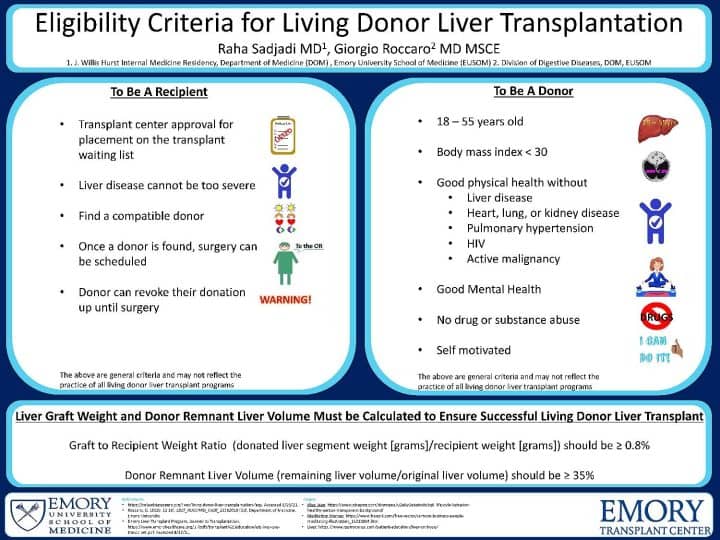Eligibility Criteria for Living Donor Liver Transplantation
Raha Sadjadi, MD and Giorgio Roccaro, MD
Emory University School of Medicine
This presentation is an excerpt from the ALF 2021 Poster Competition. This competition showcases posters and a brief video created by early career investigators from across the country on six areas of educational focus: fatty liver disease, liver cancer, liver transplantation, pediatric liver disease, rare liver disease and viral hepatitis. Participants are tasked with translating complicated medical information into a poster which can be easily understood by patients or the public. Posters are reviewed by a formal panel of judges comprised of Medical Advisory Council members, Board Members and friends of ALF to select a winner in each category.

Living donor liver transplant is a potentially life-saving alternative to deceased donor liver transplant. Potential donors and recipients must fulfill certain eligibility criteria to be considered for this procedure. This presentation will review these criteria. The criteria are guidelines which may vary slightly among liver transplant centers.
Prospective living donor liver transplant recipients must be placed on the liver transplant waiting list. For this to occur, patients must undergo a medical and psycho-social evaluation at a transplant center. If the patient is deemed an appropriate candidate for liver transplantation, they are then placed on the waiting list, after which pursuit of a living donor liver transplant can begin. Patients suitable for living donor liver transplant include those without a prior liver transplant and who are not “too sick”. This is an ill defined criteria that may be subjective to the transplant center where the patient is receiving their care.
Donors must also meet certain criteria to safely donate part of their liver and ensure a successful transplant. The donor should be between 18–55 years old with a BMI less than 30. They must be in overall good physical health, without a history of liver, heart, lung, or kidney disease or mental illness. They should not use tobacco, alcohol or illicit drugs. They should be self-motivated.
Two important metrics are calculated to ensure enough liver tissue is given to the recipient and that enough liver tissue remains in the donor: the graft to recipient weight ratio and the remnant liver volume respectively. The Graft to Recipient Weight Ratio, a ratio of the weight of the donated liver segment divided by the recipient’s total body weight, should be ≥ 0.8%. The remnant liver volume reflects the percentage of liver remaining following donation. This should be ≥ 35% to ensure donor recovery. If the above prerequisites are met, then the patient and donor should qualify for living donor transplant.
Last updated on December 1st, 2022 at 01:40 pm